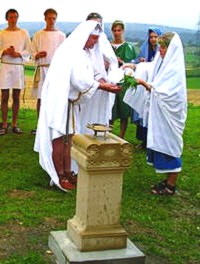“Numa appointed Numa Marcius, the son of senator Marcus, [as pontifex maximus] and all the regulations bearing on religion, written out and sealed, were placed in his charge. . . . He placed all other sacred functions, both public and private, under the supervision of the pontifex, in order that there might be an authority for the people to consult, . . . Nor were his functions confined to directing the worship of the celestial Gods; he was to instruct the people how to conduct funerals and appease the spirits of the departed (Livy 1.20).”

As Pontifex Maximus among the cultores Deorum Romana I often receive questions on the Religio Romana and what are proper practices to follow in ritual. Recently one inquiry was interesting because it asked whether a pregnant woman could become a pontifex. There is nothing that says a woman cannot be chosen to serve as a pontifex in a local community. In fact we have accepted women as pontifices in the past and they have made some of our very best pontifices. As in other traditions, the Religio Romana has certain restrictions with regard to keeping ritually pure while performing ritual. There are taboos on uncleanliness, others concerning blood, and some on pregnancy just as in Shinto and Jewish traditions (Leviticus 12:2-4). So women, and men as well, who serve as sacredotes need to be aware of the prescriptions and purify themselves when required. A woman who gives birth should not offer public ritual for the following nine days, inclusive, while she does attend to her family rituals related to the birth and also to purification rituals, as in other traditions. But there is nothing that would prohibit a pregnant woman, any more than would prevent another man or woman, per se, from being adlected a pontifex.
Neither her gender nor her condition would prevent a woman from serving as a pontifex. These things may prevent her from serving as a sacerdos for certain Gods and Goddesses, just as men are prevented from serving as a sacerdos for certain Goddesses. But the role of a pontifex is not to perform ritual as with sacerdotes. Livy above, and other ancient authors, too, made clear that Numa Pompilius, as the Founder of the Religio Romana, appointed Marcius to be the first pontifex to preserve the religious laws of the tradition and to instruct other Romans on those laws. So the qualities one should seek in a pontifex is character first and, secondly, knowledge of the mos maiorum as well as the religious law (fas) of the Religio Romana. A pontifex must be able to research and write about the Religio Romana, as well as able to teach on its traditions. He or she must be able to perform Roman ritual properly, in order to demonstrate correct practice, and with that in mind a pontifex must also keep ritual purity. Nothing about women, whether pregnant or not, mother or virgin, married or single, would bar her from instructing others as a pontifex. In fact, quite the opposite would appear to have been the case in ancient Rome:
“And because some rites were to be performed by women, others by children whose fathers and mothers were living, to the end that these also might be administered in the best manner, [Numa] ordered that the wives of the priests should be associated with their husbands in the priesthood; and that in the case of any rites which men were forbidden by the law of the country to celebrate, their wives should perform them and their children should assist as their duties required (Dionysius of Halicarnassus, Roman Antiquities 2.22.1).”
We know for a fact that the wives of sacerdotes took the leading role during certain ceremonies, as when the flaminica Dialis, wife of the priest of Jupiter, would lead the matrons in ceremonies at Vestalia, and how the Regina Sacrorum took the leading position in certain rites conducted each month. Some have tried to counter argue against including women among the pontifices by citing the example of the Ara Maxima where women were supposedly excluded from partaking in the sacral meal. “How can a woman be a pontifex,” they argued, “when a woman cannot attend the rites of Hercules.” Well, this is a false argument on two counts. In the most ancient form of these rites women were only kept from sharing in the meal, not from attending the rites themselves, and this restriction was not due to any religious reason, not really, but to social proprieties. However, that example refers to when the rites were still private. In 312 BCE the censor Appius Claudius had the rites transferred from a private family cultus to the care of the Roman state instead, and at the same time he ordered”furthermore to admit women as well (Origo Gentis Romanae 8.5).” Originally the rites of Hercules were intended to support the virility of men in a family so as to ensure procreation of the family. But the public cultus, which is what some had posed as an excuse, was intended to benefit the entire Roman community, women included. This argument is an example of why a pontifex must be knowledgeable of Roman religious law and the whole of Roman tradition in order to sort out questions of this nature with a proper determination.
Now, I have brought up this issue on what a pontifex ought to be, because it is time that I return to my duties as Pontifex Maximus among the cultores Deorum. I am not quite done with the procedures and treatments for my cancer, but what remains is not intrusive. Therefore it is about time that I once more begin instructing others who may wish to serve as sacerdotes in local Roman communities. To that end then I will begin using this blog to teach on formal Roman ritual as it may be performed either in the private homes or in public places. I should thus be posting more frequently in the days and weeks ahead. And since I respond best when questions are asked of me, I shall post some of my responses to private inquiries as they may relate to the subject of Roman ritual.















